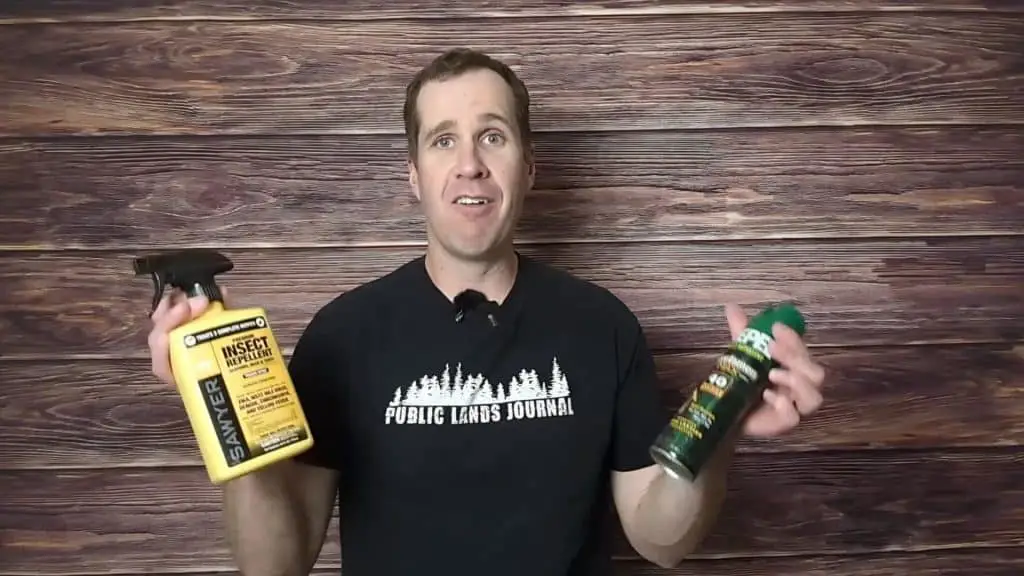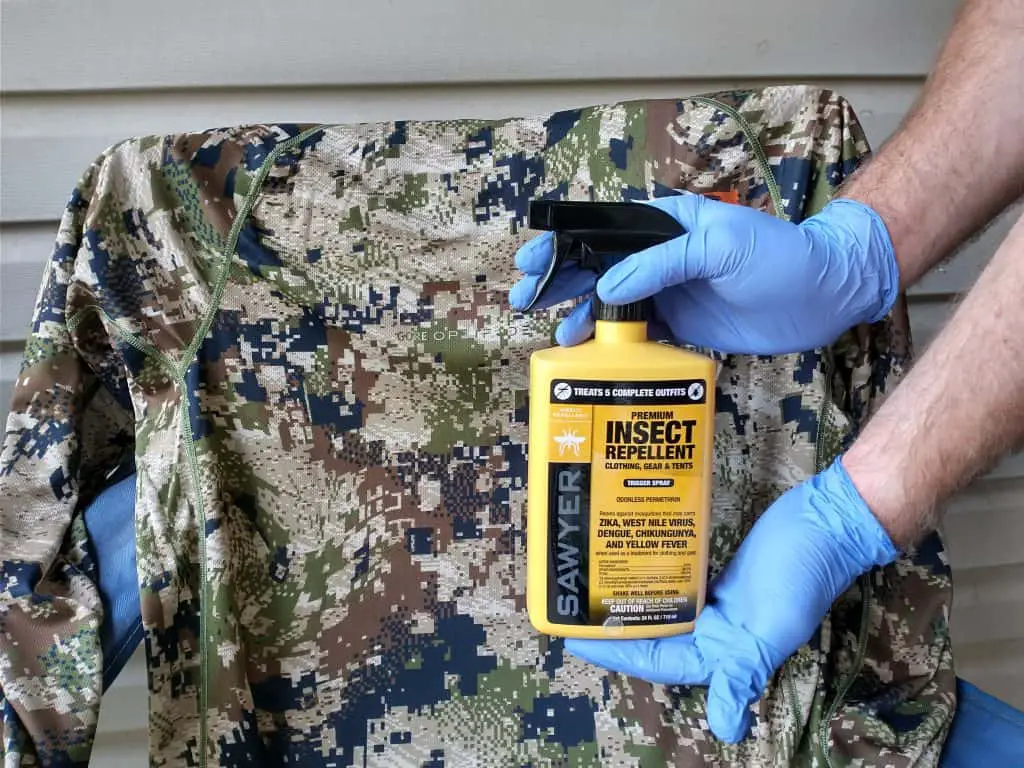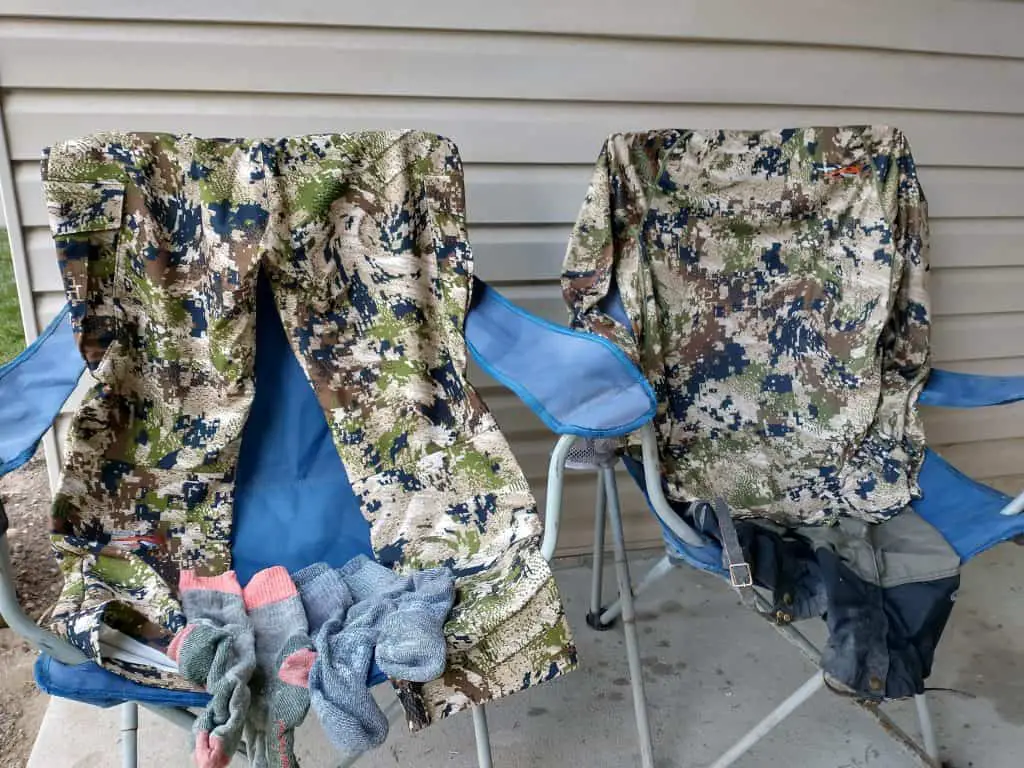Spring and summer weather make these seasons a wonderful time to be outdoors and spend time in the backcountry. However, there are also some major annoyances during these seasons. Namely ticks and mosquitos.
Ticks and mosquitos can turn a nice spring day into misery. I absolutely despise the sensation of thinking ticks are crawling on me all day (if you know you know). All it takes is finding one tick crawling across my pants to put me on edge for the rest of the trip.
No one wants to get a tick bite they don’t find and end up with Lyme disease or Rocky Mountain Spotted Fever.
Over the last couple of years, I’ve tested different tick and mosquito repellents and have found a solution that works really well. Plus it is long-lasting and convenient to apply.
Repellents I Tested

I’ve found two primary groups of tick and mosquito repellent.
- Short-lived, spray-on repellents that are applied directly to the skin or clothing. These include DEET-based repellents and more natural options.
- Clothing only repellents. These repellents are only sprayed onto clothing (some wash in). These are long-lasting repellents that typically last for weeks and can survive a couple of cycles through the wash.
I used the repellents primarily in spring and summer while I was on bear hunts or backpacking trips. Spring is the time you’re most likely to encounter ticks and I encountered many of them!
You can purchase my favorite repellent here (I’ll explain more about it below).
Downsides of Skin-Safe Repellents
I’ve used spray-on repellents for asking and clothing extensively in the backcountry.
They’re annoying. I don’t like them.
These repellents make your skin sticky. They stink. They can get in your eyes and make them burn. They taste bad (you know that you’ve put on spray right before dinner and then ate with your hands, I sure have). And you always have to reapply. The repellent just doesn’t last very long.
On top of that, you have to carry the can with you into the backcountry. It’s one extra thing to carry that gets in the way. It leaks onto your pack (one of my packs has a spot that was discolored by bug spray). Overall, it’s just annoying.
Upsides of Skin-Safe Repellents
There are really only two positive things I have to say about skin-safe bug spray.
First, you can apply it whenever and wherever you want. It’s super convenient. If you hit a swarm of mosquitos you can just pull it out and douse yourself.
Second, if you feel like it’s not working you can spray more on.
That’s it. That’s all I have.
Now let’s talk about clothing only bug repellent.
Downsides of Clothing-Only Repellents
There are three main downsides of clothing-only tick and mosquito repellents.
First, the liquid form of these chemicals (usually permethrin) is not safe to apply directly to your skin so you need to be careful when applying. Apply in a well-ventilated area and use gloves to protect your hands.
Second, they’re not convenient to apply. You have to plan ahead because you need to cover pieces of clothing with the repellent individually, and then let them dry.
Third, you only get protection where you have clothing. That means your face and hands will almost never be protected. If you like to wear shorts or short sleeves then your arms and/or legs won’t be protected.
Overall, I think these downsides are minor and are far outweighed by the upsides.

Upsides of Clothing-Only Repellents
Here’s where clothing-only repellent really shines. Once it’s applied you don’t have to worry about anything (except wearing clothes that have been treated). You don’t have to carry any repellent with you because the clothing-only repellent is long-lasting and durable. You’ll need to reapply it after you’ve washed your clothes a couple of times or after about six weeks. But until then, you’re golden
You can take a set or two of clothes on a week-long trip and not have to worry about applying repellent every couple of hours. Then you can wash those clothes and head out on another trip two weeks later without doing anything else.
On top of that, in my experience, permethrin does a better job of repelling pesky ticks and mosquitos than deet or natural deterrents.
I’ve found that permethrin-based, clothing-only repellents are especially effective against ticks. Ticks don’t fly, they have to crawl on you from the ground or vegetation (which usually contacts your clothes) so they can’t hone in on bear skin like mosquitos do.

How to Apply Permethrin-based Tick and Mosquito Repellent
There are many different varieties of permethrin-based repellents. Overall, there are two ways to apply them. The method will depend on the specific repellent you buy
First, is the spray-on method. These repellents are sprayed directly onto clothing. Make sure you get coverage on all clothing surfaces. I also like to spray a few inches inside of pant legs, shirt sleeves, and waistlines. After you’ve sprayed the clothing, let it dry completely. Then it’s ready to wear.
Second, is the wash-in method. These repellents are placed in the washing machine (like detergent) with the clothes you want to treat. You’ll wash the clothes with the repellent and dry them per the repellent instructions. Then your clothes are ready to use.
I prefer the spray on method because you can control how much repellent you apply and make sure you get every piece of clothing. With wash in options I worry that my washer will dilute the repellent too much or that I will put in too many or too few clothes (the instructions aren’t always clear).
For a repellent that I know works, check out Sawyer’s permethrin-based repellent for gear and clothes.
Which Tick and Mosquito Repellent Is Best?
I found that a permethrin-based tick and mosquito repellent (for clothing only) was the best tick and mosquito deterrent. It lasted longer and was more effective than skin-safe repellents.
My favorite permethrin-based repellent is made by Sawyer. It comes in a large bottle so you can treat 3-4 complete sets of clothing and I’ve found that works very well at preventing ticks and mosquitos. You can see it here.
The downside to the permethrin-based repellent is that it cannot be applied directly to the skin. So, if you want to wear shorts or short-sleeves you’ll need to choose a different option. Also, if using a permethrin-based repellent you may want to bring a head net to protect exposed skin on your face.
My recommendation for the best protection against ticks is to wear long pants and a long-sleeved shirt with a hood and treat both with a permethrin-based repellent. From my experience, this will give you substantially more protection, and you’ll have fewer ticks crawling on you, than any other repellent method.
